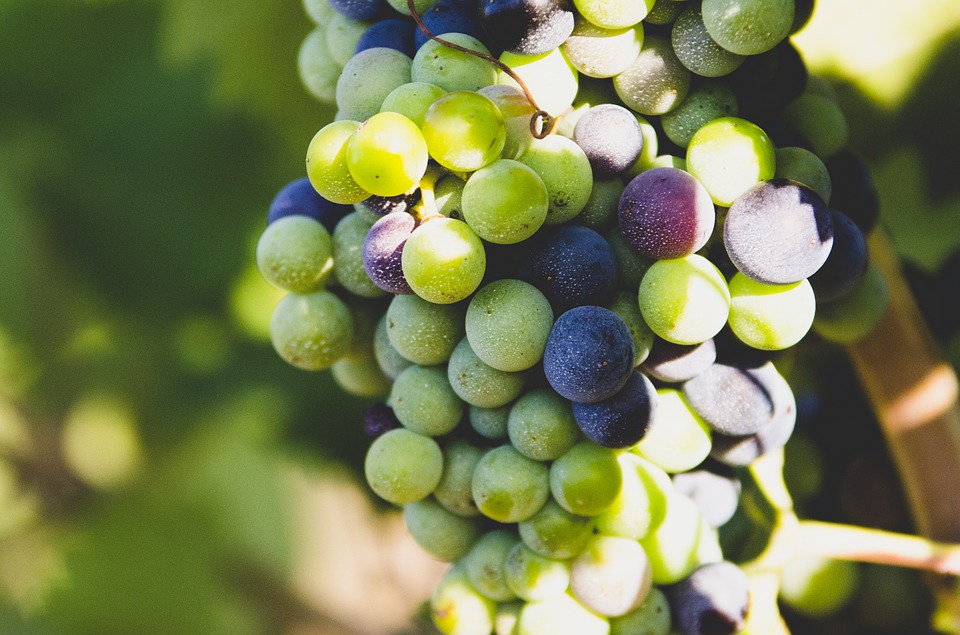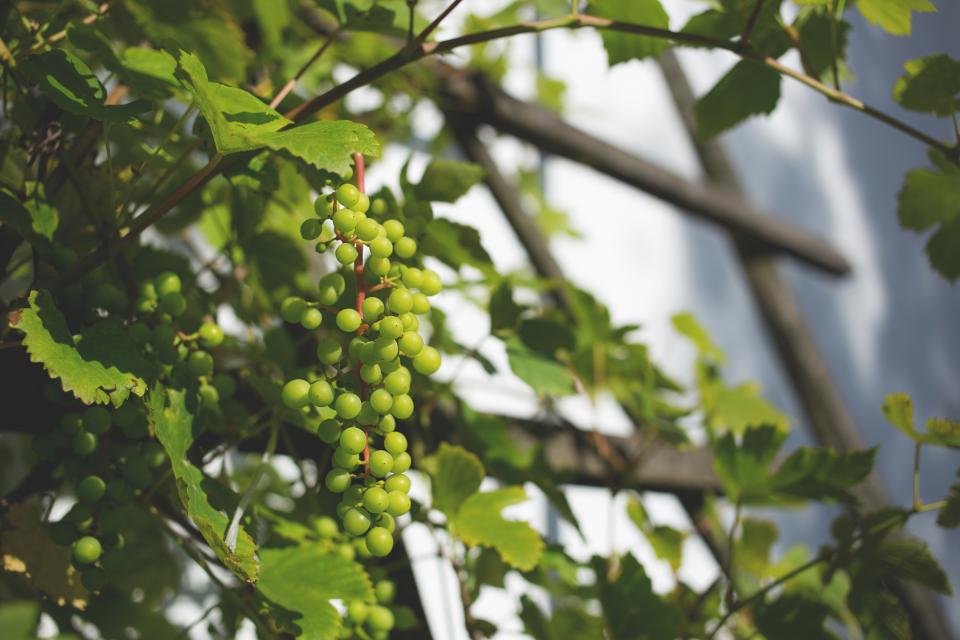This comprehensive guide will delve into the question of whether dogs can eat grapes, exploring the potential risks and benefits of this seemingly harmless fruit. We'll cover everything from the science behind grape toxicity to safe alternatives, equipping you with the knowledge you need to make informed decisions about your canine companion's diet.
Part 1: The Grape Conundrum

1.1 The Shocking Truth: Grapes are Toxic to Dogs
While grapes may be a healthy snack for humans, they pose a serious threat to our furry friends. Ingesting even a small amount can lead to severe health complications, making it crucial to keep grapes and raisins out of reach of dogs. This toxicity is not limited to a specific grape variety; all types of grapes, including green, red, and purple, are toxic to dogs. The danger lies not only in the fruit itself but also in the seeds, stems, and even the juice.
1.2 Understanding Grape Toxicity
The exact mechanism behind grape toxicity in dogs remains unknown, but it's believed to be related to a compound found in grapes that interferes with kidney function. This compound, while not yet fully identified, is thought to disrupt the kidneys' ability to filter waste products from the blood effectively. This disruption can lead to a rapid and severe decline in kidney function, resulting in acute kidney failure.
1.3 Symptoms of Grape Toxicity
Recognising the symptoms of grape toxicity is vital for prompt veterinary attention. Look out for:
- Vomiting: This is often one of the first signs, occurring within hours of ingestion. The vomit may contain undigested grapes or grape remnants.
- Diarrhoea: Similar to vomiting, diarrhoea can be a sign of gastrointestinal distress caused by grape toxicity.
- Lethargy: A significant decrease in energy levels and a general lack of interest in play or interaction.
- Loss of Appetite: Reduced or complete loss of interest in food, which can be a sign of kidney dysfunction.
- Increased Thirst: Dogs may drink more water due to dehydration caused by vomiting and diarrhoea or as a result of kidney damage.
- Abdominal Pain: Your dog may exhibit signs of abdominal discomfort, such as whimpering or guarding their abdomen.
- Increased Urination or Difficulty Urinating: Changes in urination patterns can be indicative of kidney issues. Your dog may urinate more frequently or have difficulty passing urine.
1.4 Severity of Grape Toxicity
The severity of grape toxicity depends on several factors, including:
- The amount of grapes consumed: The larger the amount ingested, the greater the risk of severe toxicity.
- The dog's size: Smaller dogs are generally more susceptible to grape toxicity due to their smaller body mass.
- The time elapsed since ingestion: The sooner veterinary care is sought after ingestion, the better the chances of successful treatment.
- The dog's overall health: Dogs with pre-existing health conditions, particularly kidney problems, are at increased risk of complications.
1.5 Raisins: A Special Case
Raisins, which are essentially dried grapes, are even more concentrated in the toxic compound, making them particularly dangerous for dogs. Even a few raisins can cause severe kidney problems. The concentration of the toxic compound is higher in raisins due to the dehydration process involved in drying.
Part 2: The Risks of Grape Consumption

2.1 Acute Kidney Failure: A Life-Threatening Condition
The most serious consequence of grape ingestion is acute kidney failure, a condition where the kidneys stop filtering waste products from the blood effectively. This can lead to a buildup of toxins in the body, causing a range of life-threatening symptoms. Symptoms of acute kidney failure include lethargy, vomiting, diarrhoea, loss of appetite, increased thirst, and difficulty urinating. If left untreated, acute kidney failure can progress to irreversible damage and ultimately lead to death.
2.2 Other Potential Health Problems
While kidney failure is the primary concern, other health issues may also arise from grape consumption, including:
- Gastrointestinal upset: Vomiting and diarrhoea are common symptoms, which can lead to dehydration and electrolyte imbalances. This can further exacerbate kidney problems by reducing blood flow to the kidneys.
- Hepatic (Liver) Issues: Some research suggests grapes may also affect liver function, although this is less common than kidney problems. The exact mechanism by which grapes may affect the liver is unclear, but it's believed to be related to the same compound that causes kidney toxicity.
- Death: In severe cases of grape toxicity, death can occur if treatment is not sought promptly. Prompt veterinary attention is crucial, as early intervention can significantly improve the chances of survival.
Part 3: What to Do if Your Dog Eats Grapes

3.1 Immediate Action: Seek Veterinary Care
If you suspect your dog has eaten grapes or raisins, seek immediate veterinary attention. Time is of the essence in treating grape toxicity, and prompt intervention can significantly improve the chances of a successful outcome. Don't delay seeking veterinary care, even if your dog appears healthy. Grape toxicity can take several hours or even days to manifest, and early treatment is essential to prevent irreversible kidney damage.
3.2 Provide Information to the Vet
When you contact the vet, be prepared to provide the following information:
- The type and quantity of grapes consumed: This information helps the vet determine the potential severity of the toxicity.
- The time of ingestion: This allows the vet to assess the timeline of events and determine the best course of action.
- Your dog's breed, age, weight, and overall health: These details are crucial for the vet to assess your dog's individual risk factors and develop a tailored treatment plan.
- Any symptoms your dog is exhibiting: A detailed description of your dog's symptoms helps the vet make a more accurate diagnosis and determine the appropriate level of urgency.
3.3 Follow the Vet's Instructions
The veterinarian will assess your dog's condition and recommend a course of action, which may include:
- Inducing vomiting: This may be recommended if the dog ingested grapes recently. Inducing vomiting can help remove undigested grapes from the stomach, reducing the amount of toxins absorbed into the bloodstream.
- Intravenous fluids: To prevent dehydration and support kidney function. Intravenous fluids help flush out toxins and maintain proper hydration, which is crucial for kidney function.
- Blood tests: To monitor kidney function and electrolyte levels. Blood tests allow the vet to track the health of your dog's kidneys and adjust treatment accordingly.
- Activated charcoal: To absorb toxins in the digestive system. Activated charcoal binds to toxins in the gut, preventing their absorption into the bloodstream.
- Other medications: Depending on the severity of the symptoms. Additional medications may be prescribed to manage vomiting, diarrhoea, pain, and other symptoms.
Part 4: Preventing Grape Toxicity
4.1 Keep Grapes Out of Reach
The most effective way to prevent grape toxicity is to keep grapes and raisins out of reach of your dog. This includes:
- Storing grapes and raisins in airtight containers or sealed bags: This prevents your dog from accessing them even if they manage to open cabinets or drawers.
- Keeping grapes out of sight, ideally in a refrigerator or pantry: Keeping grapes out of sight reduces the temptation for your dog to try and access them.
- Supervising your dog around grapes, especially during mealtimes: Always supervise your dog when grapes are present, particularly during mealtimes or when snacking on grapes.
- Teaching your dog a "leave it" command to discourage them from approaching grapes: Train your dog to leave grapes alone by using a "leave it" command and rewarding them for obedience.
4.2 Educate Family Members and Visitors
It's crucial to educate all family members, visitors, and anyone who may interact with your dog about the dangers of grapes and raisins. Remind them to:
- Keep grapes and raisins out of reach of your dog: This includes ensuring grapes are not left on counters or tables where your dog can easily access them.
- Dispose of grape scraps and leftovers properly: Always dispose of grape scraps and leftovers in a way that is inaccessible to your dog, such as a sealed trash bin.
- Avoid giving grapes or raisins to your dog as treats: Emphasize to everyone that grapes and raisins are strictly off-limits for your dog.
4.3 Be Wary of Grape-Containing Products
Beyond whole grapes and raisins, be mindful of grape-containing products, such as:
- Grape juice: Even grape juice, which seems less harmful, can contain enough of the toxic compound to cause problems for dogs.
- Grape jelly: Similar to grape juice, grape jelly can be toxic to dogs due to its high grape content.
- Grape jam: Grape jam, like jelly, contains concentrated grape product and should be avoided by dogs.
- Grape-flavoured snacks and desserts: Be especially cautious with grape-flavoured snacks and desserts, as they often contain artificial grape flavouring, which may also be harmful to dogs.
Part 5: Safe Alternatives to Grapes
5.1 Dog-Friendly Fruits and Vegetables
Fortunately, there are plenty of delicious and nutritious fruits and vegetables that are safe for dogs to enjoy. These include:
- Apples (without the core and seeds): Apples are a great source of fiber and vitamin C, but always remove the core and seeds, which contain cyanide.
- Bananas: Bananas are a good source of potassium and fiber, and dogs often enjoy their sweet taste.
- Blueberries: Blueberries are packed with antioxidants and are a healthy treat for dogs in moderation.
- Cantaloupe: Cantaloupe is a refreshing and hydrating treat for dogs, but be sure to remove the seeds and rind.
- Carrots: Carrots are an excellent source of vitamin A and can help clean teeth.
- Celery: Celery is low in calories and a good source of vitamins and minerals, making it a healthy snack for dogs.
- Cucumber: Cucumber is a refreshing and hydrating treat for dogs, and it's low in calories and fat.
- Green beans: Green beans are a good source of fiber and vitamins, and dogs often enjoy their crunchy texture.
- Mango (without the pit): Mangoes are a good source of vitamins A and C, but be sure to remove the pit, which can be a choking hazard.
- Peaches (without the pit): Peaches are a delicious and nutritious treat for dogs, but always remove the pit, which contains cyanide.
- Pumpkin (pureed or cooked): Pumpkin is a good source of fiber and can help with digestion.
- Strawberries: Strawberries are a good source of vitamin C and antioxidants, and dogs often enjoy their sweet taste.
- Watermelon (without the rind and seeds): Watermelon is a refreshing and hydrating treat for dogs, but be sure to remove the rind and seeds.
5.2 Consulting Your Veterinarian
Always consult your veterinarian before introducing any new foods to your dog's diet, especially if they have any pre-existing health conditions. They can advise on appropriate quantities and safe options based on your dog's individual needs. Your veterinarian can also provide guidance on potential allergies and other food sensitivities your dog may have.
Part 6: FAQs
6.1 Are Grapes Toxic to All Dogs?
Yes, grapes are toxic to all dogs, regardless of their breed, size, or age. The toxic compound affects all dogs, making it essential to avoid grape ingestion entirely. There are no specific breeds or individuals that are immune to grape toxicity.
6.2 How Long Does it Take for Grape Toxicity to Show Symptoms?
The onset of symptoms can vary, ranging from a few hours to several days after ingestion. This is why prompt veterinary attention is crucial, as early diagnosis and treatment can significantly improve the outcome. The time it takes for symptoms to appear depends on the amount of grapes ingested, the dog's size, and their overall health.
6.3 Can My Dog Eat Cooked Grapes?
No, even cooked grapes are toxic to dogs. The heat does not destroy the toxic compound, so cooked grapes are just as dangerous as raw grapes. Cooking grapes does not neutralize the toxic compound; it remains present and can cause harm to your dog.
6.4 Can My Dog Eat Grape Seeds?
Grape seeds are also toxic to dogs, so it's essential to ensure that your dog does not ingest any part of the grape, including the seeds. Grape seeds contain a higher concentration of the toxic compound, making them even more dangerous than the fruit itself.
6.5 What if My Dog Only Eats a Few Grapes?
Even a small amount of grapes can cause toxicity, so it's essential to seek veterinary attention regardless of the quantity ingested. The vet will assess the situation and advise on the appropriate course of action. Even a few grapes can cause significant health problems, particularly in smaller dogs.
6.6 Can I Give My Dog Grape-Flavoured Treats?
No, grape-flavoured treats are not safe for dogs. They often contain artificial grape flavouring, which can be harmful to dogs, even if they don't contain real grapes. Artificial grape flavouring can contain chemicals that may cause gastrointestinal upset and other health problems.
6.7 Is It Safe to Give My Dog Grapes if They Have Already Eaten Them Before Without Issues?
It's best to avoid grapes entirely, as there is no safe threshold for grape consumption in dogs. The toxic compound can affect any dog, regardless of prior exposure. Each dog's reaction to grape toxicity can vary, and even dogs that have previously eaten grapes without apparent problems may still be at risk.
6.8 How Can I Dispose of Grapes Safely Around My Dog?
It's crucial to dispose of grapes properly, ensuring they are out of reach of your dog. You can:
- Dispose of grape scraps in a sealed bin with a lid: This prevents your dog from accessing the bin and potentially ingesting grape scraps.
- Rinse out any containers that held grapes thoroughly: This removes any residue or traces of grapes that may attract your dog.
- Keep grapes out of sight and out of reach of your dog: Store grapes in a secure location that your dog cannot access, such as a high shelf or locked cupboard.
This comprehensive guide has provided valuable insights into the dangers of grapes for dogs, equipping you with the knowledge to protect your canine companion from this potential health hazard. Remember, your dog's health and well-being are paramount, and prevention is always the best course of action. Always consult with your veterinarian if you have any concerns or questions about your dog's diet.
Everyone is watching
-

Can Dogs Eat Bananas? A Guide to Safe Treats
DOGS & PUPPIESThis comprehensive guide will delve into the world of canine nutrition, focusing on the popular question: can ...
-

Can Dogs Eat Oranges? (Is It Safe or Toxic?)
DOGS & PUPPIESThis article delves into the question of whether dogs can safely consume oranges. We'll explore the nutrition...
-

Can Dogs Eat Grapes? The Shocking Truth About This Fruit
DOGS & PUPPIESThis article delves into the controversial topic of grapes and dogs, exploring the potential dangers associate...
-

Why Do Dogs Eat Poop? Understanding Coprophagia in Dogs
DOGS & PUPPIESThis article delves into the perplexing phenomenon of coprophagia, the act of eating faeces, in dogs. We explo...
-

Can Dogs Eat Shrimp? A Guide to Safety and Risks
DOGS & PUPPIESThis comprehensive guide dives into the world of shrimp and dogs, exploring the potential benefits and risks a...
